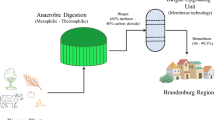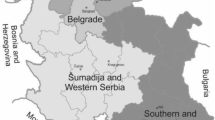Abstract
Against the background of a rapidly developing German biogas to electricity sector, this paper identifies the most profitable biogas plant configurations under the current energy–political framework conditions, by considering variable biomass inputs and prices. The paper addresses the following research question: what is the optimal biomass input to be valorized, in order to maximize the specific net operating profit of the considered plants? For the considered supply chains, i.e. energy crops with manure and biowaste valorization, kinetics as well as biological reactions are considered in order to model the biogas production. In a further step, an economic assessment for the two biogas plant types is realized by determining the annual costs, as well as by considering subsidies for the electricity generation from biogas based on the German Renewable Energy Sources Act 2012. For each of the two considered supply chains, an optimal economic operation point is determined, regarding the valorized biomass input quantity. In the case of a co-digestion from energy crops and manure, 4.32 ct/kWhel are reached for an optimal installed capacity of about 1.2 MWel. Biowaste plants show a theoretical maximal specific net operating profit of 4.97 ct/kWhel at about 4.0 MWel with biowaste subsidies at 50 €/t and for 120,000 t/a valorized substrate. Whilst agricultural plants are generally more economically attractive they exhibit a higher greenhouse gas potential, which means a trade-off. The successful future development of the German biogas sector will thus rely on overcoming several technical, social and political barriers.












Similar content being viewed by others
Notes
A plant configuration i is characterized by a defined biomass input mass flow Fi, with a price feedstock pi, a biogas volumetric flow Vi and an electric power Peli.
Marché à Terme International de France.
A detailed list of substrates allocated to the two classes can be found in the annex of the Biomass Ordinance [38].
References
Balussou, D., Kleyböcker, A., McKenna, R., Möst, D., Fichtner, W.: An economic analysis of three operational co-digestion biogas plants in Germany. Waste Biomass Valoris. 3(1), 23–41 (2011)
Rauh, S.: Perspektiven der Biogasnutzung als teil der deutschen Energieversorgung. In: Proceedings of the Conference Biogas in der Landwirtschaft-Stand und Perspektiven (2011)
Balussou, D., McKenna, R., Fichtner, W.: Forecasting the development of German Biogas plants until 2030, 20th European Biomass Conference and Exhibition, (2012)
Arlt, A: Systemanalytischer Vergleich zur Herstellung von Ersatzbrennstoffen aus biogenen Bioabfällen am Beispiel von kommunalem Klärschlamm, Bioabfall und Grünabfall, S.98, (2003)
FNR: Studie Einspeisung von Biogas in das Erdgasnetz, Fachagentur Nachwachsende Rohstoffe e.V., 2. Edition, Leipzig (2006)
Leipzig, I. E., Müller-Langer, F., PErimenis, A., Brauer, S., Thrän D., Kaltschmitt, M.: Technische und ökonomische Bewertung von Bioenergies-Konversionspfaden, WBGU Hauptgutachten Berlin (2008)
Koch, M.: Ökologische und ökonomische Bewertung von Co-Vergärungsanlagen und deren Standortwahl, Karlsruhe, Dissertation, p. 129 (2009)
Arlt, A.: Systemanalytischer Vergleich zur Herstellung von Ersatzbrennstoffen aus biogenen Bioabfällen am Beispiel von kommunalem Klärschlamm, Bioabfall und Grünabfall, S.191 (2003)
Koch, M.: Ökologische und ökonomische Bewertung von Co-Vergärungsanlagen und deren Standortwahl, Karlsruhe, Dissertation, p. 128 (2009)
Stenull, M.: Nachhaltigkeitsstrategie Baden-Württemberg Forum für nachhaltige Biogaserzeugung in Baden Württemberg, Beitrag zur Arbeitsgruppe 3 Systemanalyse Teil Klimaschutz/Treibhausgasemissionen, (2010)
Balussou, D., Kleyböcker, A., McKenna, R., Möst, D., Fichtner, W.: An economic analysis of three operational co-digestion biogas plants in Germany. Waste Biomass Valoris. 3(1), 33 (2011)
KTBL-a: „Profitability calculatror biogas“Kuratorium für Technik und Bauwesen in der Landwirtschaft (KTBL)/Fachagentur Nachwachsender Rohstoffe (FNR). http://daten.ktbl.de/biogas/, consulted im Mai (2013)
FNR: Fachagentur nachwachsende Rohstoffe, Biogasmessprogramm II, 61 Biogasanlagen im Vergleich, Fachagentur Nachwachsende Rohstoffe e.V, (2009)
KTBL: Profitability calculator Biogas Kuratorium für Technik und Bauwesen in der Landwirtschaft (KTBL)/Fachagentur Nachwachsender Rohstoffe (FNR). http://daten.ktbl.de/biogas/, consulted im July (2013)
Balussou, D., Kleyböcker, A., McKenna, R., Möst, D., Fichtner, W.: An economic analysis of three operational co-digestion biogas plants in Germany. Waste Biomass Valoris. 3(1), 23–41 (2011)
Pantaleo, A., De Gennaro, B., Shah, N.: Assessment of optimal size of anaerobic co-digestion plants: an application to cattle farms in the province of Bari (Italy). Renew. Sustain. Energy Rev. 20, 57–70 (2013)
Walla, C., Schneeberger, W.: The optimal size for biogas plants. Biomass Bioenergy 32, 551–557 (2008)
Karellas, S., Boukis, I., Konotpoulos, G.: Development of an investment decision tool for biogas production from agricultural waste. Renew. Sustain. Energy Rev. 14, 1273–1282 (2010)
BMU Gesetz für den Vorgang Erneuerbare Energien (Erneuerbare-Energien-Gesetz-EEG). Berlin (2012)
Thrän, D., Fischer, E., Fritsche, U., Hennenberg, K., Oehmichen, K., Pfeiffer, D., Schmersahl, R., Schröder, T., Zeller, V., Zeymer, M.: Methoden zur stoffstromorientierten Beurteilung für Vorhaben im Rahmen des BMU-Förderprogramms “Energetische Biomassenutzung” (2010)
Roels, J.A.: Energetics and kinetics in biotechnology. Elsevier Biomedical Press, Amsterdam (1983)
Palmowski, L., Müller, J.: Influence of the size reduction of organic waste on their anaerobic digestion. In: Mata-Alvarez, J., Cecchi, F., Tilche, A. (eds.) Proceedings of 2nd International Symposium on Anaerobic Digestion of Solid Waste: 137–144. IWA Publishing, London (1999)
Gerber, M., Span, R.: An Analysis of Available Mathematical Models for Anaerobic Digestion of Organic Substances for Production of Biogas, International Gas Union research Conference, Paris (2008)
Buswell, A.M., Neave, S.L.: Laboratory studies of sludge digestion, Bulletin No. 30, State of Illinois, Department of registration and education, division of the state water survey (1930)
Harrison, R., Todd, P., Rudge, S., Petrides, D.: Bioseparations science and engineering. Oxford University Press, New York (2003)
German Biomass Research Center (DBFZ): Press release from April 19th. http://www.dbfz.de/web/presse/pressemitteilungen-2012/zubau-der-kapazitaeten-bei-biogasanlagen-uebertrifft-2011-die-vorjahre.html. Accessed 12 Feb 2013
KTBL (Kuratorium für Technik und Bauwesen in der Landwirtschaft): Wirtschaftlichkeitsrechner Biogas. http://daten.ktbl.de/biogas. Accessed 16 June 2013
ASUE, BHKW-Kenndaten 2011, Berlin. Arbeitsgemeinschaft für sparsamen und umweltfreundlichen Energieverbrauch e.V., (2011)
Chauvel, A., Fournier, G., Raimbault, C.: Manual of process economic evaluation-new, revised and expanded edition. Editions Technip, Paris (2003)
Perry, R.J., Chilton, C.H.: Chemical engineers handbook. McGraw-Hill, New York (1973)
Strauch, U.: Modulare Kostenschätzung in der chemischen Industrie-Konzept eines integrierten Systems zur Abschätzung und Bewertung des Kapitalbedarfs für die Errichtung einer chemischen Anlage. Berlin: s.n., p. 42–43 (2008)
Peters, M.S., Timmerhaus, K.D., West, R.E.: Plant design and economics for chemical engineers, vol. 17, p. 988. McGraw-Hill, Boston (2003)
Heinzle, E., Biwer, A., Cooney, C.: Development of sustainable bioprocesses: modeling and assessment. Wiley, England (2006)
Koch, M.: Ökologische und ökonomische Bewertung von Co-Vergärungsanlagen und deren Standortwahl, Karlsruhe, Dissertation (2009)
Kuratorium für Technik und Bauwesen in der Landwirtschaft e.V. (KTBL): Faustzahlen Biogas; 2. Auflage, Darmstadt (2009)
Bundesamt, Statistisches: Land- und Forstwirtschaft, Fischerei—Vieh-bestand. Vorbericht), Wiesbaden (2012)
Eder, B.; Krieg, A.: Biogas-Praxis Grundlagen Planung Anlagenbau Beispiele Wirtschaftlichkeit Umwelt, 5. Überarbeitete Auflage 2012, ökobuch Verlag, Staufen bei Freiburg (2012)
Biomasse V. 28.07.2011. FNA (2011): 754-15-1; 7 Wirtschaftsrecht 75 Bergbau, Kernenergie, Elektrizität, Gas, Wasserwirtschaft; Energieversorgung 754 Energieversorgung (2011)
Kern, M.; Raussen, T.: Optimierte stoffliche und energetische Bioabfallverwertung, Witzenhausen-Institut (2009)
Koch, K., Lübken, M., Gehring, T., Wichern, M., Horn, H.: Biogas from grass silage—Measurements and modeling with ADM1. Bioresour. Technol. 2011, 21–41 (2011)
Balussou, D.; Möst, D.; Fichtner, W.: La nouvelle loi allemande sur les énergies renouvelables: principe et application au cas du biogaz. In: Energie PLUS (2009)
Kleyboecker, A., Liebrich, M., Vestraete, W., Kraume, M., Wuerdemann, H.: Early warning indicators for process failure due to organic overloading by rapeseed oil in one-stage continuously stirred tank reactor, sewage sludge and waste digesters. Bioresour. Technol. 123, 534–541 (2012)
Kleyboecker, A., Liebrich, M., Kasina, M., Kraume, M., Wittmaier, M., Wuerdemann, H.: Comparison of different procedures to stabilize biogas formation after process failure in a thermophilic waste digestion system: Influence of aggregate formation on process stability. Waste Manage. 32, 1122–1130 (2012)
Lienen, T., Kleyböcker, A., Verstraete, W., Wuerdemann, H.: Foam formation in a downstream digester of a cascade running full-scale biogas plant: Influence of fat, oil and grease addition and abundance of the filamentous bacterium Microthrix parvicella. Bioresour. Technol. (2013)
Lienen, T., Kleyböcker, A., Brehmer, M., Kraume, M., Moeller, L., Goersch, K., Wuerdemann, H.: Floating layer formation, foaming, and microbial community structure change in full-scale biogas plant due to disruption of mixing and substrate overloading. Energy Sustain. Soc. 3, 20 (2013)
Würdemann, H., Kleyböcker, A., Lienen, T., Brehmer, M., Kraume, M., Daniel-Gromke, J., Lorenz, H., Balussou, D., McKenna, R., Möller, L., Görsch, K., Müller, R., Zehnsdorf, A., Zirkler, D., Kaupenjohann, M.: OptGas: Vergleichenden Untersuchungen an grosstechnischen Biogasreaktoren, in prep. (2013)
Wunderlich, C.: Akzeptanz und Bürgerbeteiligung für Erneuerbare Energien Erkenntnisse aus Akzeptanz und Partizipationsforschung, Renews Spezial Ausgabe 60, Agentur für Erneuerbare Energien (2012)
Reise, C., Liebe, U., Musshoff, O.: Design of substrate supply contracts for biogas plants. In: 56th AARES Annual Conference, Fremantle, Australia (2012)
Acknowledgments
The present work has been carried out in the context of the research project “Optgas: comparative investigations in large biogas reactors—microbiological, process-related, ecological and economical assessment and optimisation”, financed by the Federal Ministry for the Environment, Nature Conservation and Nuclear Safety in cooperation with the German Centre For Geosciences Potsdam, with funding code 03KB018F.
Author information
Authors and Affiliations
Corresponding author
Rights and permissions
About this article
Cite this article
Balussou, D., Heffels, T., McKenna, R. et al. An Evaluation of Optimal Biogas Plant Configurations in Germany. Waste Biomass Valor 5, 743–758 (2014). https://doi.org/10.1007/s12649-013-9284-1
Received:
Accepted:
Published:
Issue Date:
DOI: https://doi.org/10.1007/s12649-013-9284-1




